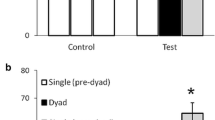Abstract
Spatial organization is an extensively studied field, in which most of the research has been on how the physical environment is perceived and conceived. There is a consensus that physical attributes such as environment geometry and landmarks are key factors in shaping spatial cognition. Nevertheless, the numerous studies of spatial behavior have usually been carried out on individuals, thereby overlooking the possible impact of the social environment. In the present study, rats were exposed to an unfamiliar open-field, first alone and then in tetrads of unfamiliar individuals, in order to monitor and analyze when and how their individual spatial behavior converged to a group spatial behavior. We found that the unfamiliar rats spent most of their time in companionship, first with preferred partners and ultimately as a quartet. Specifically, group formation was dynamic and gradual, with the rats first forming duos, then trios, and ultimately a quartet. Trios and quartets mostly huddled in the same specific corner that became a shared home base, from which they took solo or duo roundtrips to the arena. The present study unveils how, by means of gradual interactions among self, place, and conspecifics, four unfamiliar rats organized together their social spatial behavior.






Similar content being viewed by others
References
Amici F, Aureli F, Call J (2008) Fission–fusion dynamics, behavioral flexibility, and inhibitory control in primates. Curr Biol 18:1415–1419. doi:10.1016/j.cub.2008.08.020
Ancona DG, Goodman PS, Lawrence BS, Tushman ML (2001) Time: a new research lens. Acad Manag Rev 26:645–663. doi:10.5465/amr.2001.5393903
Arrow H, Poole MS, Henry KB et al (2004) Time, change, and development: the temporal perspective on groups. Small Group Res 35:73–105. doi:10.1177/1046496403259757
Ballard DI, Tschan F, Waller MJ (2008) All in the timing: considering time at multiple stages of group research. Small Group Res 39:328–351. doi:10.1177/1046496408317036
Bar-Yam Y (1997) Dynamics of complex systems. Addison-Wesley, Reading
Bastian M, Heymann S, Jacomy M (2009) Gephi: an open source software for exploring and manipulating networks. In: Proceedings of international AAAI conference on web and social media, pp 361–362
Ben-Yehoshua D, Yaski O, Eilam D (2011) Spatial behavior: the impact of global and local geometry. Anim Cogn 14:341–350. doi:10.1007/s10071-010-0368-z
Bernstein IS, Mason WA (1963) Group formation by Rhesus monkeys. Anim Behav 11:28–31. doi:10.1016/0003-3472(63)90004-6
Bowen MT, Keats K, Kendig MD et al (2012) Aggregation in quads but not pairs of rats exposed to cat odor or bright light. Behav Process 90:331–336. doi:10.1016/j.beproc.2012.03.014
Cheng K (1986) A purely geometric module in the rat’s spatial representation. Cognition 23:149–178. doi:10.1016/0010-0277(86)90041-7
Cheng K (2005) Reflections on geometry and navigation. Conn Sci 17:5–21. doi:10.1080/09540090500138077
Cheng K (2008) Whither geometry? Troubles of the geometric module. Trends Cogn Sci 12:355–361. doi:10.1016/j.tics.2008.06.004
Cheng K, Newcombe NS (2005) Is there a geometric module for spatial orientation? Squaring theory and evidence. Psychon Bull Rev 12:1–23. doi:10.3758/BF03196346
Cheng K, Spetch ML (1998) Mechanisms of landmark use in mammals and birds. In: Healy SD (ed) Spatial representation in animals. Oxford University Press, New York, pp 1–17
Clark BJ, Hamilton DA, Whishaw IQ (2006) Motor activity (exploration) and formation of home bases in mice (C57BL/6) influenced by visual and tactile cues: modification of movement distribution, distance, location, and speed. Physiol Behav 87:805–816. doi:10.1016/j.physbeh.2006.01.026
Collett T (1996) Insect navigation en route to the goal: multiple strategies for the use of landmarks. J Exp Biol 199:227–235
Couzin ID (2006) Behavioral ecology: social organization in fission–fusion societies. Curr Biol 16:R169–R171. doi:10.1016/j.cub.2006.02.042
Cross PC, Lloyd-Smith JO, Getz WM (2005) Disentangling association patterns in fission–fusion societies using African buffalo as an example. Anim Behav 69:499–506. doi:10.1016/j.anbehav.2004.08.006
Dorfman A, Nielbo KL, Eilam D (2016) Traveling companions add complexity and hinder performance in the spatial behavior of rats. PLoS ONE 11:e0146137. doi:10.1371/journal.pone.0146137
Eichenbaum H (2014) Time cells in the hippocampus: a new dimension for mapping memories. Nat Rev Neurosci 15:732–744. doi:10.1038/nrn3827
Eichenbaum H (2015) The hippocampus as a cognitive map … of social space. Neuron 87:9–11. doi:10.1016/j.neuron.2015.06.013
Eilam D (2014) Of mice and men: building blocks in cognitive mapping. Neurosci Biobehav Rev 47:393–409. doi:10.1016/j.neubiorev.2014.09.010
Eilam D, Golani I (1989) Home base behavior of rats (Rattus norvegicus) exploring a novel environment. Behav Brain Res 34:199–211. doi:10.1016/S0166-4328(89)80102-0
Etienne AS, Maurer R, Séguinot V (1996) Path integration in mammals and its interaction with visual landmarks. J Exp Biol 199:201–209
Etienne AS, Boulens V, Maurer R et al (2000) A brief view of known landmarks reorientates path integration in hamsters. Naturwissenschaften 87:494–498. doi:10.1007/s001140050766
Forsyth DR (2006) Group dynamics, 4th edn. Thomson Higher Education, Belmont
Gallistel CR, Matzel LD (2013) The neuroscience of learning: beyond the Hebbian synapse. Annu Rev Psychol 64:169–200. doi:10.1146/annurev-psych-113011-143807
Golledge RG (ed) (1999) Human wayfinding and cognitive maps. In: Wayfinding behavior: cognitive mapping and other spatial processes. The Johns Hopkins University Press, pp 5–45
Gouteux S, Thinus-Blanc C, Vauclair J (2001) Rhesus monkeys use geometric and nongeometric information during a reorientation task. J Exp Psychol Gen 130:505–519. doi:10.1037/0096-3445.130.3.505
Hafting T, Fyhn M, Molden S et al (2005) Microstructure of a spatial map in the entorhinal cortex. Nature 436:801–806. doi:10.1038/nature03721
Heider F (1958) The psychology of interpersonal relations. J Mark 56:322. doi:10.1037//0022-3514.46.1.57
Hines DJ, Whishaw IQ (2005) Home bases formed to visual cues but not to self-movement (dead reckoning) cues in exploring hippocampectomized rats. Eur J Neurosci 22:2363–2375. doi:10.1111/j.1460-9568.2005.04412.x
Keller MR, Brown MF (2011) Social effects on rat spatial choice in an open field task. Learn Motiv 42:123–132. doi:10.1016/j.lmot.2010.12.004
Kropff E, Carmichael JE, Moser M-B, Moser EI (2015) Speed cells in the medial entorhinal cortex. Nature 523:419–424. doi:10.1038/nature14622
Kummer H (1971) Primate societies: group techniques of ecological adaptation. Aldine Transaction, Piscataway
Maaswinkel H, Gispen WH, Spruijt BM (1997) Executive function of the hippocampus in social behavior in the rat. Behav Neurosci 111:777–784. doi:10.1037/0735-7044.111.4.777
Mintz M, Russig H, Lacroix L, Feldon J (2005) Sharing of the home base: a social test in rats. Behav Pharmacol 16:227–236
Newcomb TM (1961) The acquaintance process. Holt, Rinehart & Winston, New York
O’Keefe J, Dostrovsky J (1971) The hippocampus as a spatial map. Preliminary evidence from unit activity in the freely-moving rat. Brain Res 34:171–175. doi:10.1016/0006-8993(71)90358-1
O’Keefe J, Nadel L (1978) The hippocampus as a cognitive map, vol 3. Clarendon Press, Oxford
Ohayon S, Avni O, Taylor AL et al (2013) Automated multi-day tracking of marked mice for the analysis of social behaviour. J Neurosci Methods 219:10–19. doi:10.1016/j.jneumeth.2013.05.013
Pearce JM, Ward-Robinson J, Good M et al (2001) Influence of a beacon on spatial learning based on the shape of the test environment. J Exp Psychol Anim Behav Process 27:329–344. doi:10.1037/0097-7403.27.4.329
Popa-Lisseanu AG, Bontadina F, Mora O, Ibañez C (2008) Highly structured fission–fusion societies in an aerial-hawking, carnivorous bat. Anim Behav 75:471–482. doi:10.1016/j.anbehav.2007.05.011
Portugali J, Yaski O, Eilam D (2011) Arena geometry and path shape: when rats travel in straight or in circuitous paths? Behav Brain Res 225:449–454. doi:10.1016/j.bbr.2011.07.055
Proulx MJ, Todorov OS, Taylor Aiken A, de Sousa AA (2016) Where am I? Who am I? The relation between spatial cognition, social cognition and individual differences in the built environment. Front Psychol 7:64. doi:10.3389/fpsyg.2016.00064
Ramos-Fernnandez G, Morales JM (2014) Unraveling fission–fusion dynamics: how subgroup properties and dyadic interactions influence individual decisions. Behav Ecol Sociobiol 68:1225–1235. doi:10.1007/s00265-014-1733-8
Schiller D, Eichenbaum H, Buffalo EA et al (2015) Memory and space: towards an understanding of the cognitive map. J Neurosci 35:13904–13911. doi:10.1523/JNEUROSCI.2618-15.2015
Shelton AL, Clements-Stephens AM, Lam WY et al (2012) Should social savvy equal good spatial skills? The interaction of social skills with spatial perspective taking. J Exp Psychol Gen 141:199–205. doi:10.1037/a0024617
Shemesh Y, Sztainberg Y, Forkosh O et al (2013) High-order social interactions in groups of mice. Elife 2:1–19. doi:10.7554/eLife.00759
Shi Q, Ishii H, Kinoshita S et al (2013) Modulation of rat behaviour by using a rat-like robot. Bioinspir Biomim 8:1–10. doi:10.1088/1748-3182/8/4/046002
Shi Q, Ishii H, Tanaka K et al (2015) Behavior modulation of rats to a robotic rat in multi-rat interaction. Bioinspir Biomim 10:56011. doi:10.1088/1748-3190/10/5/056011
Smith JE, Kolowski JM, Graham KE et al (2008) Social and ecological determinants of fission–fusion dynamics in the spotted hyaena. Anim Behav 76:619–636. doi:10.1016/j.anbehav.2008.05.001
Smith-Aguilar SE, Ramos-fernández G, Getz WM (2016) Seasonal changes in socio-spatial structure in a group of free-living spider monkeys (Ateles geoffroyi). PLoS ONE 11:1–28. doi:10.1371/journal.pone.0157228
Solstad T, Boccara CN, Kropff E et al (2008) Representation of geometric borders in the entorhinal cortex. Science 322(5909):1865–1868. doi:10.1126/science.1166466
Song C, Qu Z, Blumm N, Barabási A-L (2010) Limits of predictability in human mobility. Science 327:1018–1021. doi:10.1126/science.1177170
Sovrano VA, Bisazza A, Vallortigara G (2005) Animals’ use of landmarks and metric information to reorient: effects of the size of the experimental space. Cognition 97:121–133. doi:10.1016/j.cognition.2004.08.003
Sundaresan SR, Fischhoff IR, Dushoff J, Rubenstein DI (2007) Network metrics reveal differences in social organization between two fission–fusion species, Grevy’s zebra and onager. Oecologia 151:140–149. doi:10.1007/s00442-006-0553-6
Symington MM (1990) Fission–fusion social organization in Ateles and Pan. Int J Primatol 11:47–61. doi:10.1007/BF02193695
Taube JS, Muller RU, Ranck JB (1990a) Head-direction cells recorded from the postsubiculum in freely moving rats. I. Description and quantitative analysis. J Neurosci 10:420–435
Taube JS, Muller RU, Ranck JB (1990b) Head-direction cells recorded from the postsubiculum in freely moving rats. II. Effects of environmental manipulations. J Neurosci 10:436–447
Tavares RM, Mendelsohn A, Grossman Y et al (2015) A map for social navigation in the human brain. Neuron 87:231–243. doi:10.1016/j.neuron.2015.06.011
Tolman EC (1948) Cognitive maps in rats and men. Psychol Rev 55:189–208. doi:10.1037/h0061626
Tuckman BW (1965) Developmental sequence in small groups. Psychol Bull 63:384–399. doi:10.1037/h0022100
van Schaik CP (1999) The socioecology of fission–fusion sociality in orangutans. Primates 40:69–86. doi:10.1007/BF02557703
Walsh V (2003) A theory of magnitude: common cortical metrics of time, space and quantity. Trends Cogn Sci 7:483–488. doi:10.1016/j.tics.2003.09.002
Wang M-Y, Brennan CH, Lachlan RF, Chittka L (2015) Speed–accuracy trade-offs and individually consistent decision making by individuals and dyads of zebrafish in a colour discrimination task. Anim Behav. doi:10.1016/j.anbehav.2015.01.022
Weiss O, Segev E, Eilam D (2015) “Shall two walk together except they be agreed?” Spatial behavior in rat dyads. Anim Cogn 18:39–51. doi:10.1007/s10071-014-0775-7
Weissbrod A, Shapiro A, Vasserman G et al (2013) Automated long-term tracking and social behavioural phenotyping of animal colonies within a semi-natural environment. Nat Commun 4:1–10. doi:10.1038/ncomms3018
Yaski O, Eilam D (2008) How do global and local geometries shape exploratory behavior in rats? Behav Brain Res 187:334–342. doi:10.1016/j.bbr.2007.09.027
Acknowledgements
This study was supported by the Israel Science Foundation Grant 230/13 to DE. We are grateful to Naomi Paz for language editing. DE is a Visiting Professor at the Department of OTANES, University of South Africa.
Author information
Authors and Affiliations
Corresponding author
Ethics declarations
Conflict of interest
The authors declare that they have no conflict of interest.
Ethical standards
This study and the maintenance conditions for the rats were carried out under the regulations and approval of the Institutional Committee for Animal Experimentation at Tel-Aviv University (permit # L-14-026).
Rights and permissions
About this article
Cite this article
Weiss, O., Segev, E. & Eilam, D. Social spatial cognition in rat tetrads: how they select their partners and their gathering places. Anim Cogn 20, 409–418 (2017). https://doi.org/10.1007/s10071-016-1063-5
Received:
Revised:
Accepted:
Published:
Issue Date:
DOI: https://doi.org/10.1007/s10071-016-1063-5




